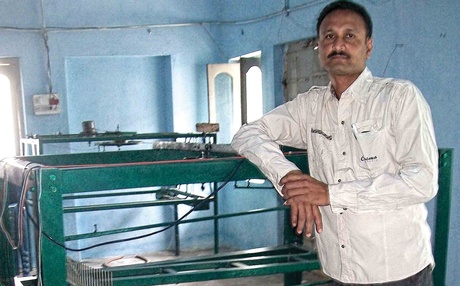Chintakindi Mallesham with his invention.
Necessity is the mother of invention, but these days, it’s exactly the reverse: invention is the mother of necessity. But for Chintakindi Mallesham, the age old adage stands true. For, the plight of his mother and other Pochampalli weavers impelled him to innovate. He designs machine for weavers, who live at the far end of dirt roads in Sharjipet village, Nalgonda in Andhra Pradesh, as well as in other villages in India. His invention costs Rs 16,000. The idea germinated in his mind in 1992. Reason: his mother’s tired arms. “You can’t understand how difficult asu—the tying of threads and dyeing them in selected colours—is,” he says. It is this understanding of tedium and tired muscles that Mallesham brings to his work.
Despite lacking a formal education or technical training, Mallesham has made a machine that has mechanised the most tedious part of Pochampally weaving—the tying of threads and dyeing them in selected colours. He replaced the woman’s arm with a mechanical one, which winds the silk thread on the pins and offers a choice of settings. The result is that the thread needed for three or four sarees is now processed in a reduced timespan. He has named the machine, Laxmi Asu, as a tribute to his mother.
The journey wasn’t easy, Mallesham was burdened by the loans he took to develop the machine and had to leave it unfinished and work in Hyderabad as a daily wager. In the journey to his invention, once he got stuck, since he did not know which parts to use to provide for one particular movement in the asu process. He then worked in a machine shop where he spent time observing various machines, searching for that one elusive movement. “The owner used to shout at me,” recalls Mallesham, a school dropout. “Finally, one day I found it and rushed off, without my wages for the day. My machine was ready.”
His achievement has made Forbes magazine list him as one of the seven most outstanding rural entrepreneurs of India in 2010. “The Pochampally saree involves weaving patterns on the loom. The yarn has to be wound with hand using the ‘asu’ process, according to the design. This might involve even moving multiple pegs over 9000 to 10,000 times, for each saree. By doing this manually, many weavers suffer from joint pains and strain their eye,” explains Mallesham. The Lakshmi Asu, he explains, does the weaving in 90 minutes against 5 hours with the manual process and enables more innovative designs. Only 200 watts equivalent to the power consumption of an air cooler usage is consumed.
Initially, he was at the receiving end from family and villagers who saw his preoccupation with the machine as an excuse to escape earning a livelihood. So it took seven years to introduce the first prototype of Laxmi Asu.
“The first few customers gave feedback that there should be some technical modifications, and I worked on that too,” says Mallesham. I have sold about 600 machines but most weaver families cannot afford the money. Their lives can change if the government helps them buy the machine,” says Mallesham.
source: http://www.newindianexpress.com / Home> Magazine / by Swati Sharma / January 13th, 2013

I know his invention, Great personality!
Congratulations! Padma Sri Mallesham Uncle